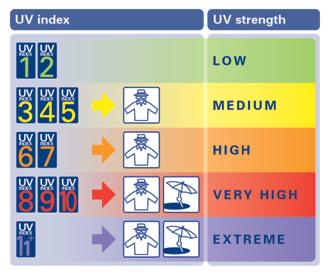| UV Index
The UV index is an international standard measurement of how strong the ultraviolet (UV) radiation from the sun is at a particular place on a
particular day. It is a scale primarily used in daily forecasts aimed at the general public.
Its purpose is to help people to effectively protect themselves from UV light, of which excessive exposure causes sunburns, eye damage such as
cataracts, skin aging, and skin cancer. Public-health organizations recommend that people protect themselves (for example, by applying sunscreen
to the skin and wearing a hat) when the UV index is 3 or higher; see the table below for complete recommendations.
Description
The UV index is an open-ended linear scale, with higher values representing the risk level of skin damage due to UV exposure. An index of 0
corresponds to zero UV irradiation, as is essentially the case at night time. While an index of 10 corresponds roughly to mid-day sun and a
clear sky, indices greater than 11 are quite common in the southern hemisphere where the Ozone layer is depleted. Values as high as 17 have been
recorded in Carnarvon, Western Australia and in Mareeba, Queensland. The numbers are related to the amount of UV radiation reaching the
surface of the earth, measured in W/m2 (Watt per Meter2: the amount of energy required to heat or cool
one square meter), but the relationship is not simple (see below for definition) because UV power is spread unevenly over a spectrum of
wavelengths; the shorter wavelengths are much more damaging. By weighting their effect the index aims to create a number that cannot be expressed
in physical units, but is a good indication of likely skin damage.
While the UV index can be calculated from a direct measurement of the UV spectral power at a given place, the value given in weather forecasts
is usually a prediction based on a computer model. While this may be in error, as with all predictions, it is essentially the same index as we
would expect to measure.
The UV index announced in weather forecasts is a prediction of how strong the actual UV intensity will be at the sun's highest point in the day,
which typically occurs during the four-hour period surrounding solar noon. The prediction is made by a computer model that accounts for the
effects of sun altitude, air mass, and inclement weather (clouds), which increase or decrease, the amount of UV radiation that will reach the
surface. The calculations are weighted in favor of the UV wavelengths to which human skin is most sensitive according to the McKinlay-Diffey
Erythema action spectrum. Providing the public with an easy-to-understand daily forecast of UV intensity is the main purpose of the UV index.
Some inexpensive portable devices also measure actual UV index.
Definition
The UV index is a number linearly related to the intensity of UV radiation reaching the surface of the earth at a given point. It cannot be
simply related to the irradiance (measured in W/m2) because the UV of concern occupies a spectrum of wavelength from 295 to 325 nm and shorter
wavelengths have already been absorbed a great deal when they arrive at the Earth's surface. Skin damage, however, is related to wavelength, the
shorter wavelengths being much more significant. The UV power spectrum (strictly expressed in watts per square meter per nanometre of wavelength)
is therefore weighted according to a weighting curve known as the McKinlay-Diffey Erythema action spectrum, and the result integrated over the
whole spectrum. This typically gives a figure of around 250 in mid-day sun and so is arbitrarily divided by 25 to generate a convenient index
value, which becomes essentially a scale of 0 to 10 (though ozone depletion is now resulting in values above ten as commented above). Because
the scale is linear and not logarithmic, as is often the case when measuring things such as sound level or brightness, it is reasonable to
assume that one hour of exposure at index ten is approximately equivalent to two hours at index 5, although other factors like the body's
ability to repair damage over a given time period could detract from the validity of this assumption.
To illustrate the weighting principle, the incident power density in mid-day sun is typically 0.6 mW/(nm m2) at 295 nm, 74 mW/(nm m2) at 305 nm
and 478 mW/(nm m2) at 325 nm. (Note the huge absorption that has already taken place in the atmosphere at short wavelengths.) The weighting
factors applied to these figures are 1.0, 0.22, and 0.03 respectively. (Also note the huge increase in damage caused by the shorter wavelength,
i.e., 305 nm is 22% as damaging as 295 nm, and 325 nm is 3% as damaging as 295 nm.) Integration of these values using all the intermediate
weighting values over the spectral range of 305 nm to 325 nm produces a figure of 264, which is then divided by 25 to give an index of 10.6.
History
In 1992, three scientists from Environment Canada developed the UV index, and made Canada the first country in the world to broadcast forecasts
of the predicted daily UV levels for the next day. Several other countries followed suit with their own UV indices, among them the United States
in 1994. Until recently, the methods of calculating and reporting a UV index varied from country to country. Today, a worldwide UV index,
standardized by the World Health Organization (WHO), has replaced the inconsistent regional methods. The international UV index not only
specifies a uniform calculation method but also standard colors and graphics for printed media. In the USA, the WHO index replaced the original
US index in 2004. In 2005, the United States and Australia launched the UV Alert. While the two countries have different baseline UV
intensity requirements before issuing an alert, the goal is to raise awareness of the dangers of overexposure to the sun on days with intense
UV radiation.
|




